Private sector rent statistics: 2010 - 2019
This publication presents statistics on private sector rent levels in Scotland over the years 2010 to 2019.
Broad Rental Market Area Profiles
This section provides profiles for private rents in each of the 18 Broad Rental Market Areas[7]. The commentary focusses on annual changes and 9 year cumulative changes for average (mean) rents by property sizes, as well as changes over time to the bottom end (lower quartile) and top end (upper quartile) of the rental markets. The commentary does not cover changes to median rents given that these often show similar trends to mean rents, however users may also wish to look at the median figures and trends in the profile tables and charts[8].
The map on the following page illustrates the different geographical areas covered by each Broad Rental Market Area. It is also possible to search for the Broad Rental Market Area associated with a particular postcode at http://lha-direct.voa.gov.uk/search.aspx. This website provides detailed PDF maps of each area.
The infographic below illustrates the changes in average rents in each area by property size.
Excel versions of each of the Broad Rental Market Area Profiles along with an online Interactive Excel Workbook, in which different rental measures, Broad Rental Market Areas and property sizes can be selected and compared in the same chart, are both available at http://www.gov.scot/Topics/Statistics/Browse/Housing-Regeneration.
Broad Rental Market Area Map
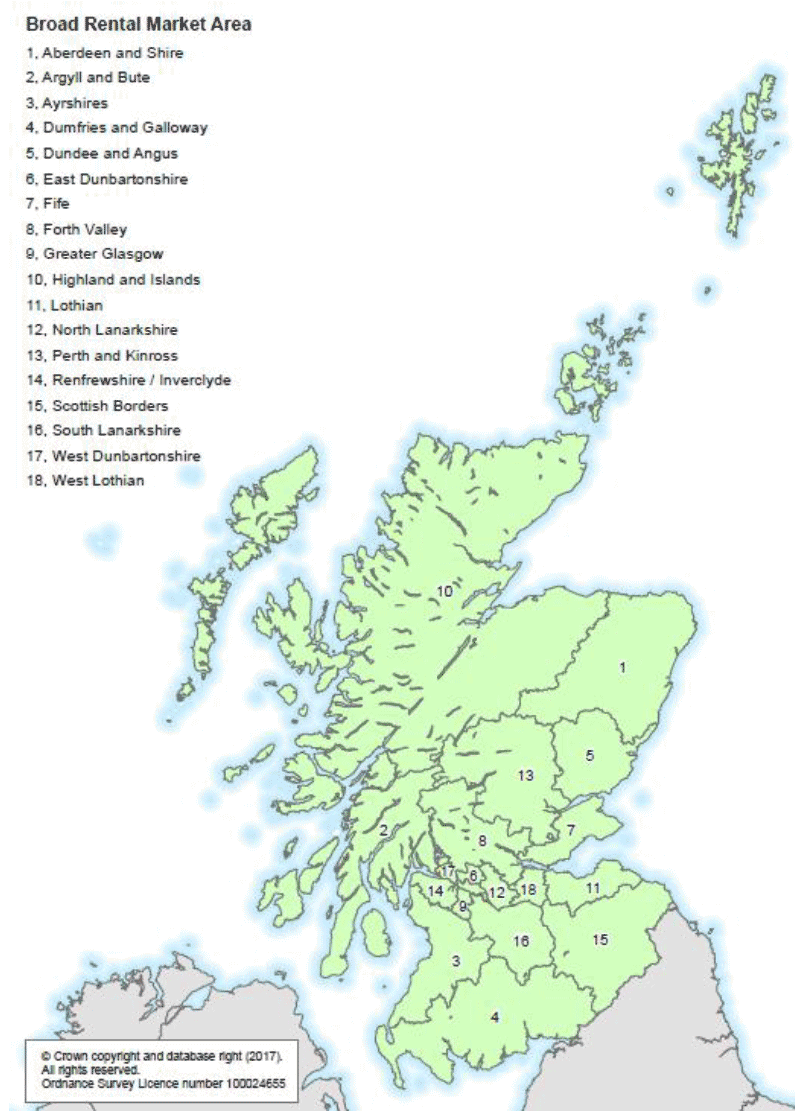
Average Private Rent Levels in Scotland, 2010 to 2019
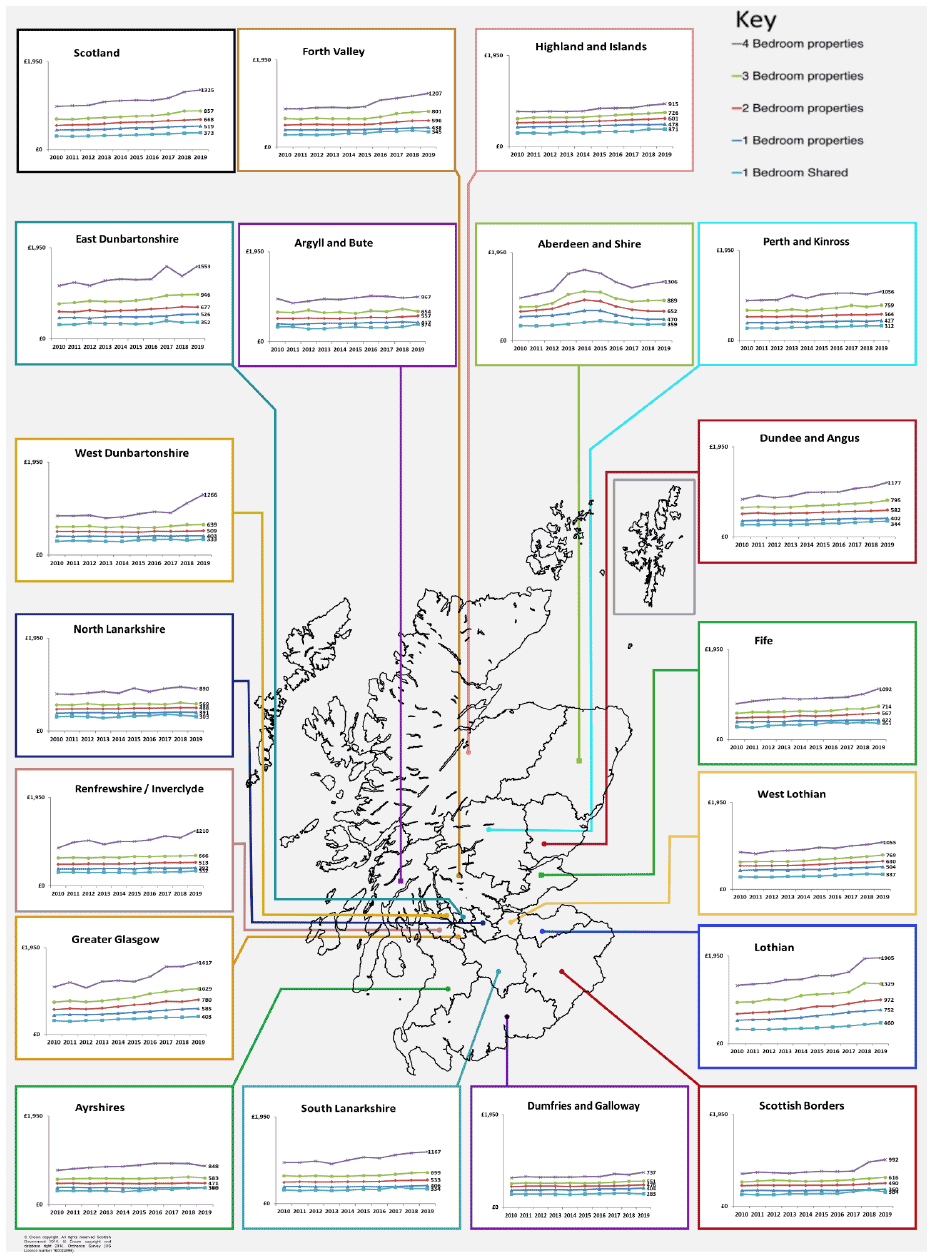
Broad Rental Market Area Profile - Aberdeen and Shire
Rents in Aberdeen and Shire showed some mixed trends in the latest year, with decreases in average (mean) rents between 2018 and 2019 for 1 bedroom (-0.5%) and 2 bedroom (-0.3%) properties, but increases for 1 bedroom shared (1.4%), 3 bedroom (0.4%) and 4 bedroom (4.5%) properties, which compares to CPI inflation of 1.7% across this time period. This follows decreases between 2015 and 2017 in average rents across all property size categories, likely to be due to decreased demand for rental properties following the downturn in the oil industry. Average rents in 2019 are still higher than in 2010 except for 1 bedroom properties, for which rents are 11.1% lower than in 2010. For 4 bedroom properties, rents in 2019 are 38.4% higher than in 2010, which is higher than CPI inflation (20.8%) over this period.
For 3 and 4 bedroom properties, greater increases at the top end (upper quartile) than the bottom end (lower quartile) between 2012 and 2014 caused the gap between the top end and bottom ends to widen. This gap has narrowed in more recent years, although it has slightly increased again from 2018 to 2019.
The average 2 bedroom rent in 2019 was £652 per month, slightly lower than the Scotland average of £668 which is a reflection of rents in Aberdeen and Shire falling since 2014 and remaining relatively stable from 2018 to 2019 while the Scotland average has increased each year over this time period.
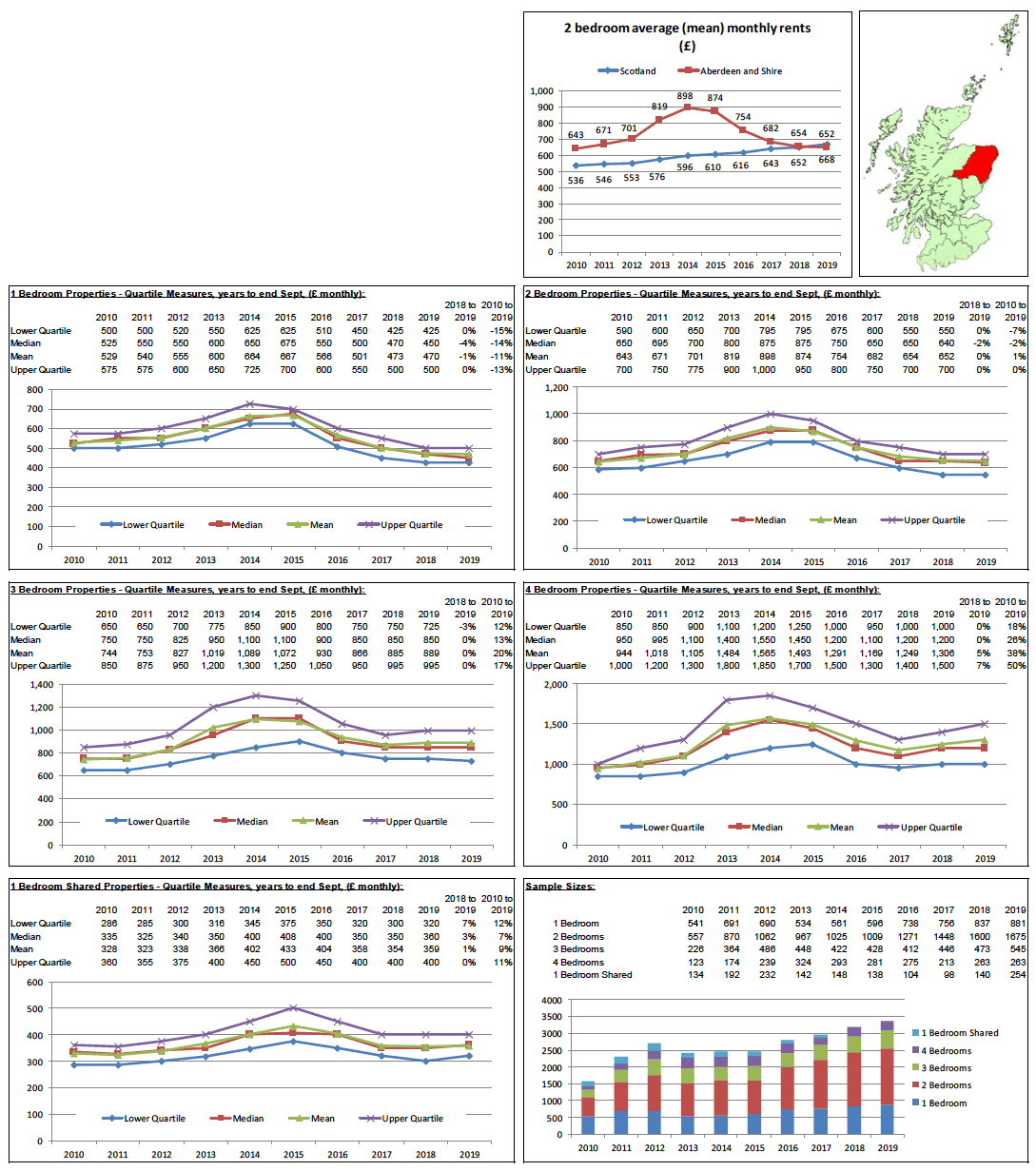
Broad Rental Market Area Profile - Argyll and Bute
Average (mean) rents in Argyll and Bute have increased between 2018 and 2019 for 2 bedroom (3.9%), 4 bedroom (2.2%), and 1 bedroom shared properties (16.8%), but have fallen for 1 bedroom properties (-1.8%) and 3 bedroom (-7.4%) properties, which compares to CPI inflation of 1.7% across this time period. Between 2010 and 2019, average rents have increased for all property sizes, ranging from 2.6% for 3 bedroom properties to 18.5% for 1 bedroom shared properties, which compares to CPI inflation of 20.8% across this time period.
3, 4 and 1 bedroom shared properties have each seen some variation each year since 2010 in the gap between the higher end (upper quartile) and lower end (lower quartile) of the market, although all of these sizes of properties have seen the gap narrow slightly in the latest year.
Average 2 bedroom rents have been lower than the Scotland average in each year since 2010. Although the gap has grown over the years, this has decreased slightly in the latest year with the average rent in 2019 being £557 per month, compared to the Scotland average of £668.
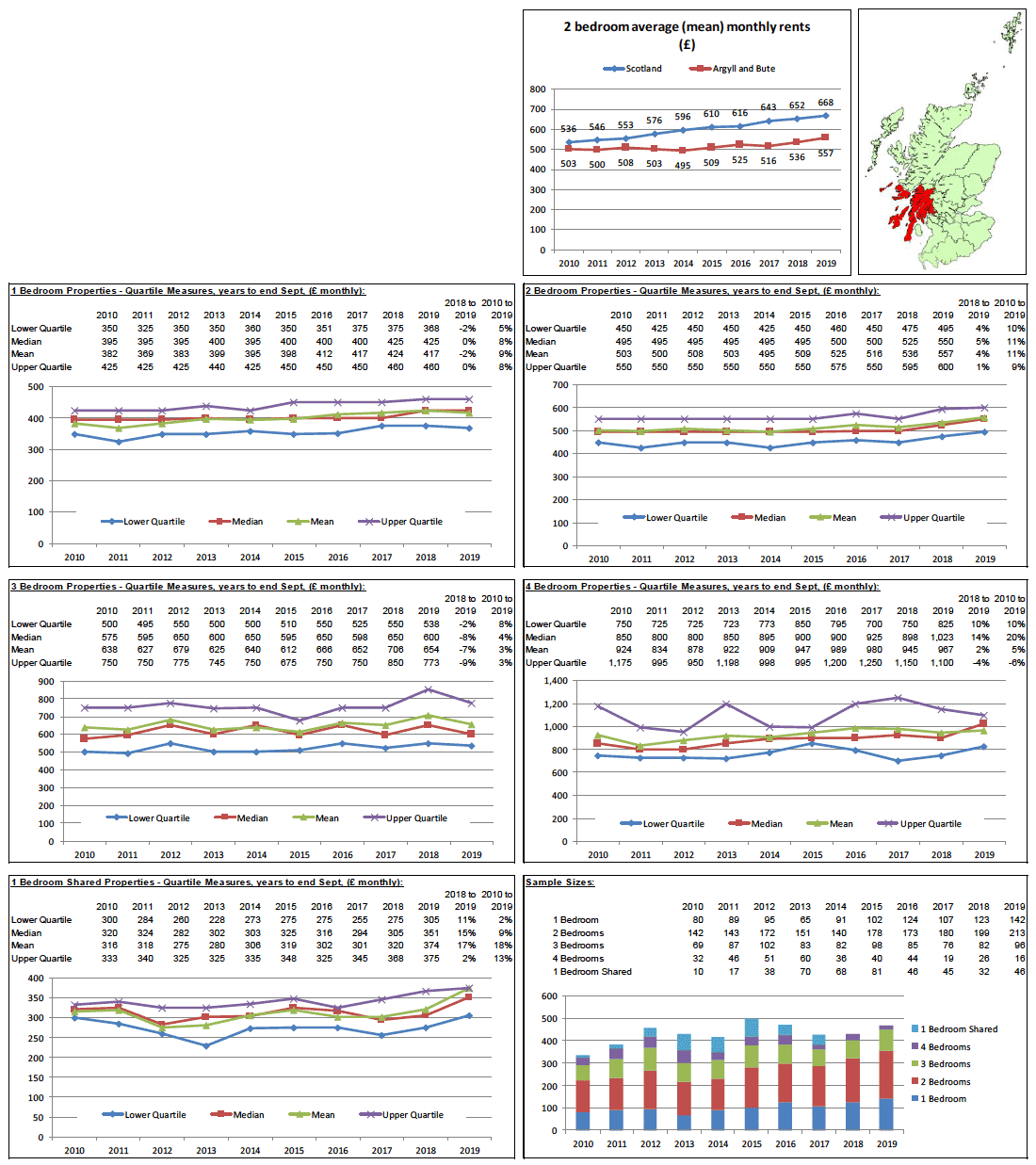
Broad Rental Market Area Profile - Ayrshires
Between 2018 and 2019 average (mean) rents have decreased for 1 bedroom (-0.1%), 2 bedroom (-0.7%), 3 bedroom (-4.0%) properties, and 4 bedroom properties (-6.2%), but have increased for 1 bedroom shared properties (2.8%), which compares to CPI inflation of 1.7% across this time period. Between 2010 and 2019, average rents have increased for all property sizes, except 1 bedroom rents which dropped by 1.4%. The largest increase has been seen for 1 bedroom shared properties (22.3%), which has been higher than CPI inflation of 20.8% across this time period.
For 1 bedroom properties, a decrease in the bottom end (lower quartile) has increased the gap between bottom end and top end rents in the latest year.
Average 2 bedroom rents have been lower than the Scotland average in each year since 2010, and the gap has grown over the years, with the average rent in 2019 being £471 per month, compared to the Scotland average of £668.
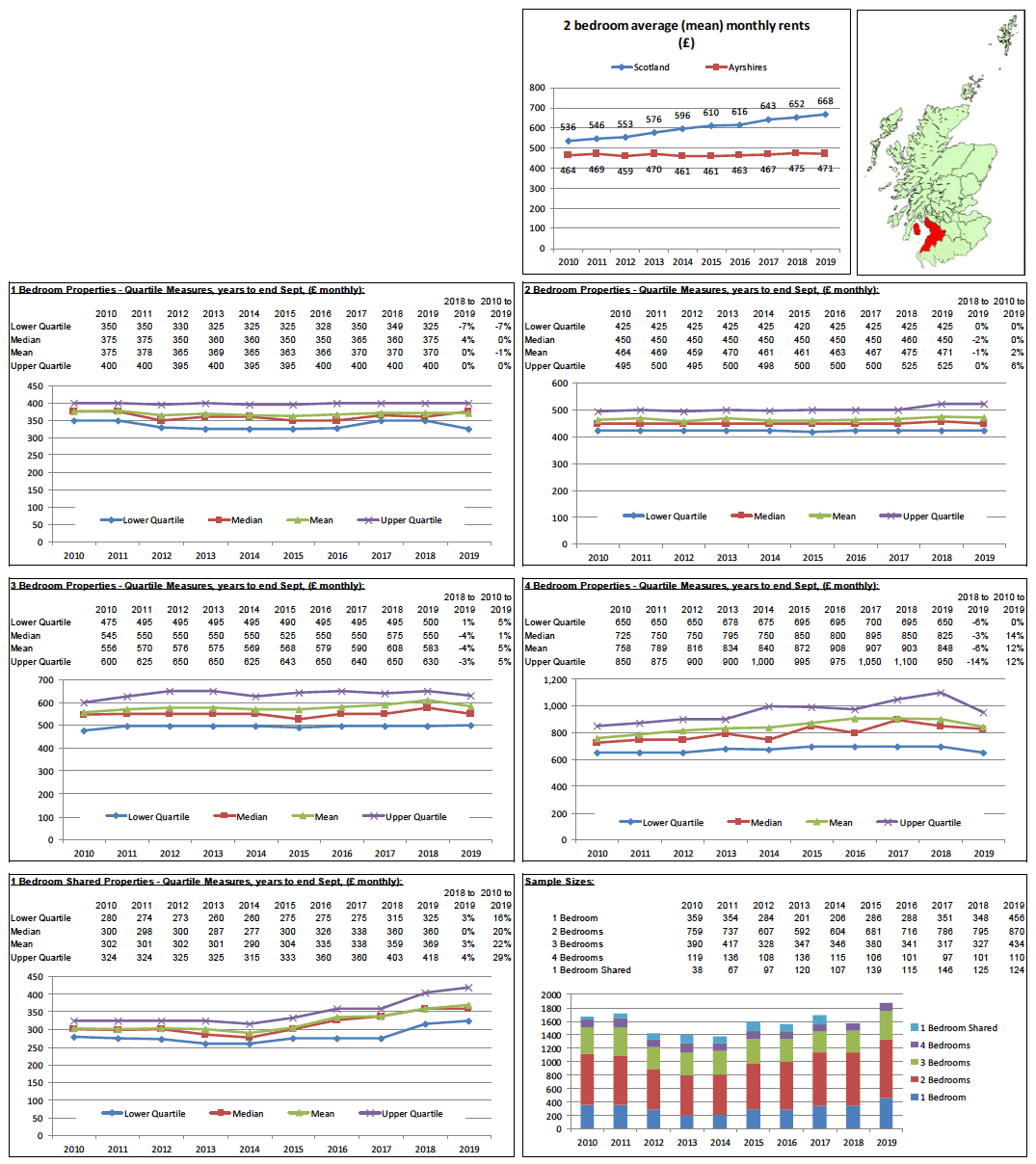
Broad Rental Market Area Profile - Dumfries and Galloway
Average (mean) rents in Dumfries and Galloway between 2018 and 2019 have increased for 1 bedroom (4.0%), 2 bedroom (3.0%), 3 bedroom (0.8%) properties, and 4 bedroom properties (7.0%), but have fallen for 1 bedroom shared properties (-3.9%), which compares to CPI inflation of 1.7% across this time period. Between 2010 and 2019 average rents have increased for all property sizes, ranging from 1.9% for 1 bedroom shared properties up to 18.8% for 4 bedroom properties. This compares to CPI inflation of 20.8% across this time period.
In the latest year, 3 bedroom and 4 bedroom have seen rents at the bottom end (lower quartile) increase narrowing the gap between the lower end and the upper end.
Average 2 bedroom rents have been lower than the Scotland average in each year since 2010, and the gap has grown over the years, with the average rent in 2019 being £476 per month, compared to the Scotland average of £668.
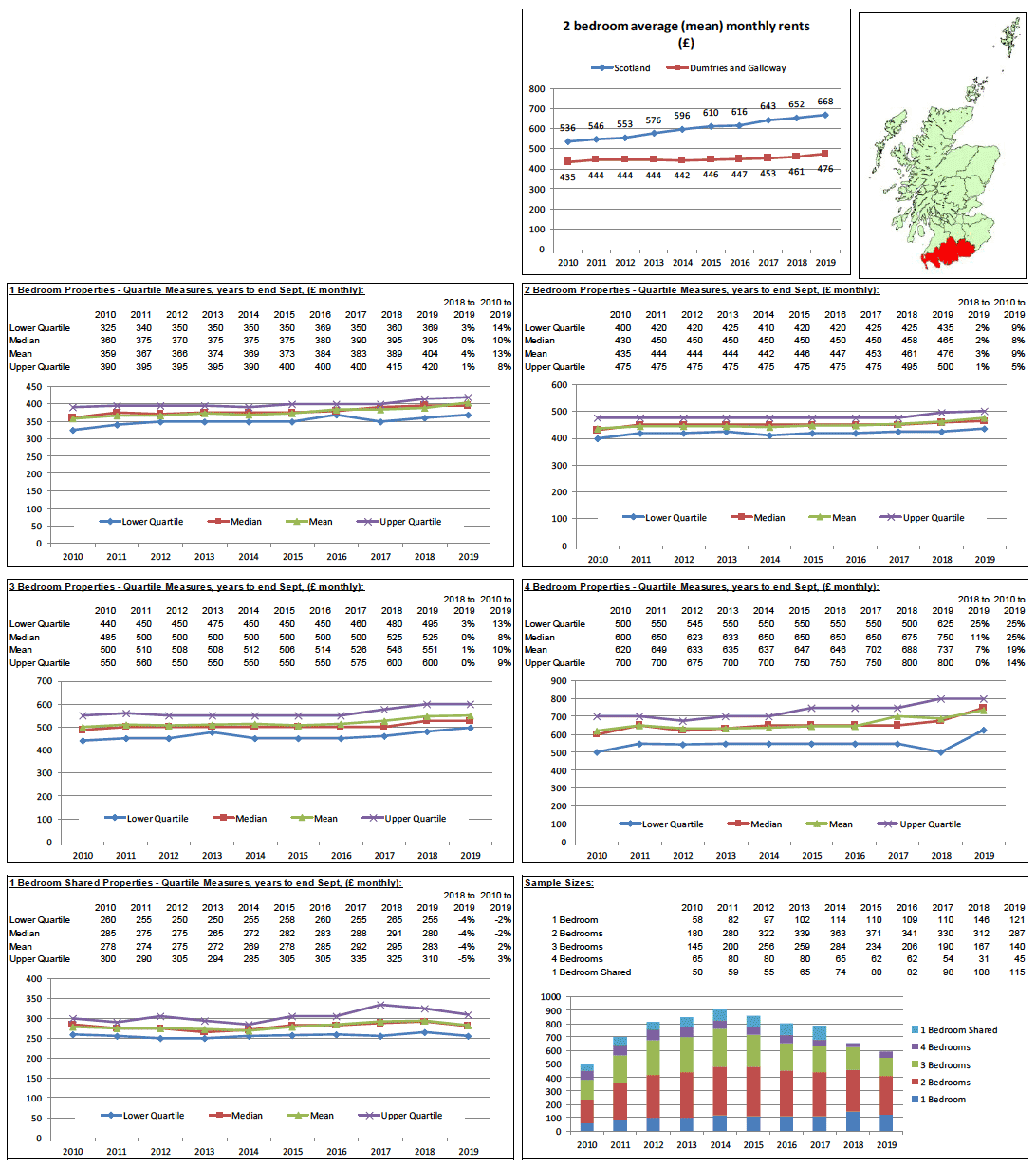
Broad Rental Market Area Profile - Dundee and Angus
Average (mean) rents between 2018 and 2019 have increased for all property sizes with increases seen for 1 bedroom properties (2.9%), 2 bedroom (3.6%), 3 bedroom (6.6%), 4 bedroom (8.5%) properties, and 1 bedroom shared properties (3.5%), which compares to CPI inflation of 1.7% across this time period. Average rents for all property sizes have also increased between 2010 and 2019, with increases ranging from 14.4% for 1 bedroom properties to 45.1% for 4 bedroom properties, which compares to CPI inflation of 20.8% across this time period.
For 3 bedroom properties increases between 2010 and 2019 have been greater at the top end (upper quartile) than the bottom end (lower quartile), causing the gap between top and bottom ends of the market to widen.
Average 2 bedroom rents have been lower than the Scotland average in each year since 2010, but this gap has narrowed slightly in the most recent year with the average rent in 2019 being £582 per month, compared to the Scotland average of £668.
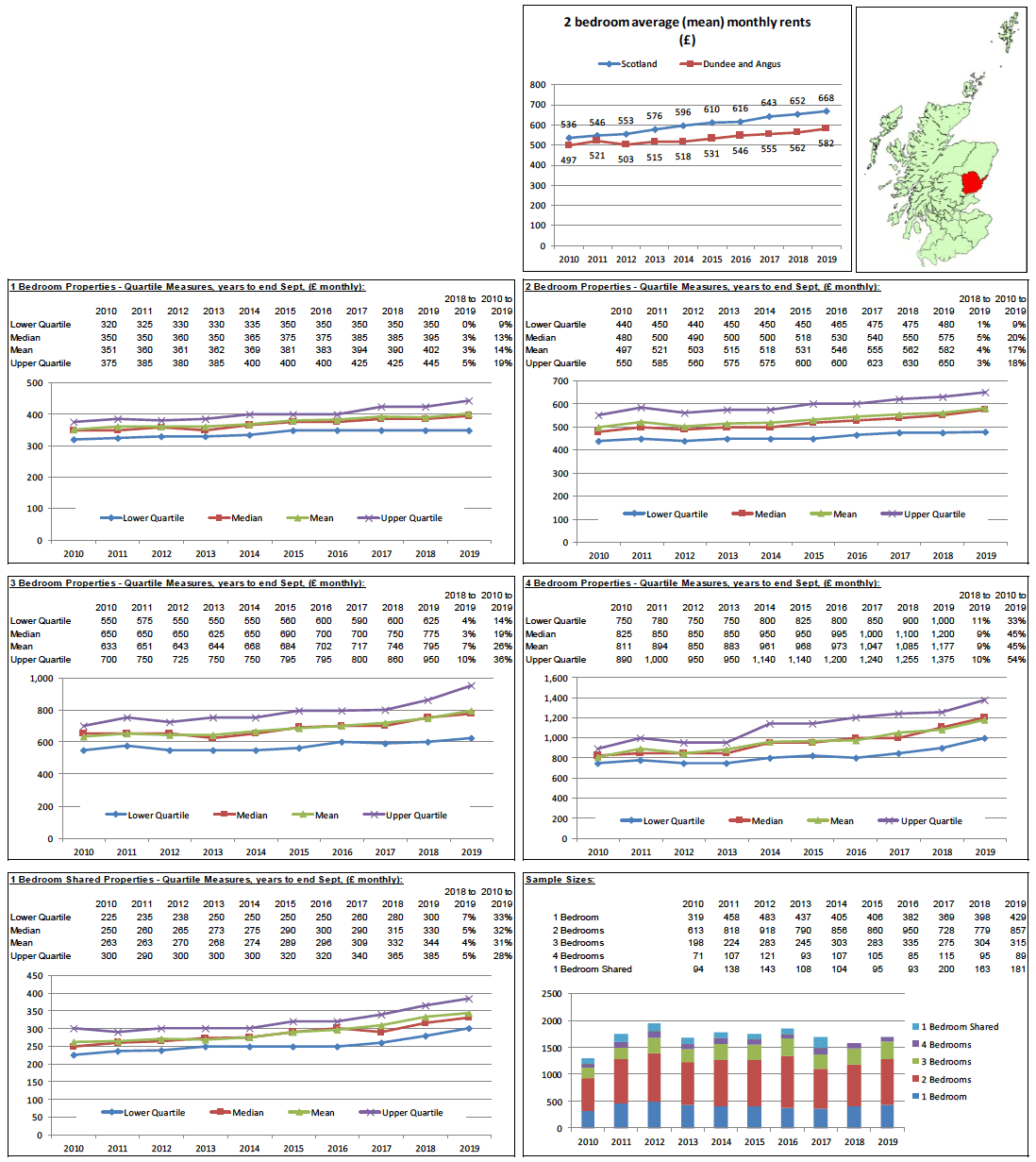
Broad Rental Market Area Profile - East Dunbartonshire
Average (mean) rents in East Dunbartonshire have increased for increased for 1 bedroom (0.8%), 3 bedroom (1.0%), 4 bedroom (15.6%) and 1 bedroom shared properties (1.6%), but have fallen for 2 bedroom properties (-1.0%), which compares to CPI inflation of 1.7% across this time period. Average rents for all property sizes have increased between 2010 and 2019, with increases ranging from 16.5% for 2 bedroom properties to 36.8% for 4 bedroom properties, respectively, which compares to CPI inflation of 20.8% across this time period.
For 1 bedroom properties, rents between 2010 and 2019 have increased more at the top end (upper quartile) that at bottom end (lower quartile) of the market, causing a slight widening of the gap between the top and bottom end of the market.
Average 2 bedroom rents have been higher than the Scotland average in each year since 2010, although rents have been only slightly higher than the Scotland figures since 2013 onwards, with the average rent in 2019 being £677 per month, compared to the Scotland average of £668.
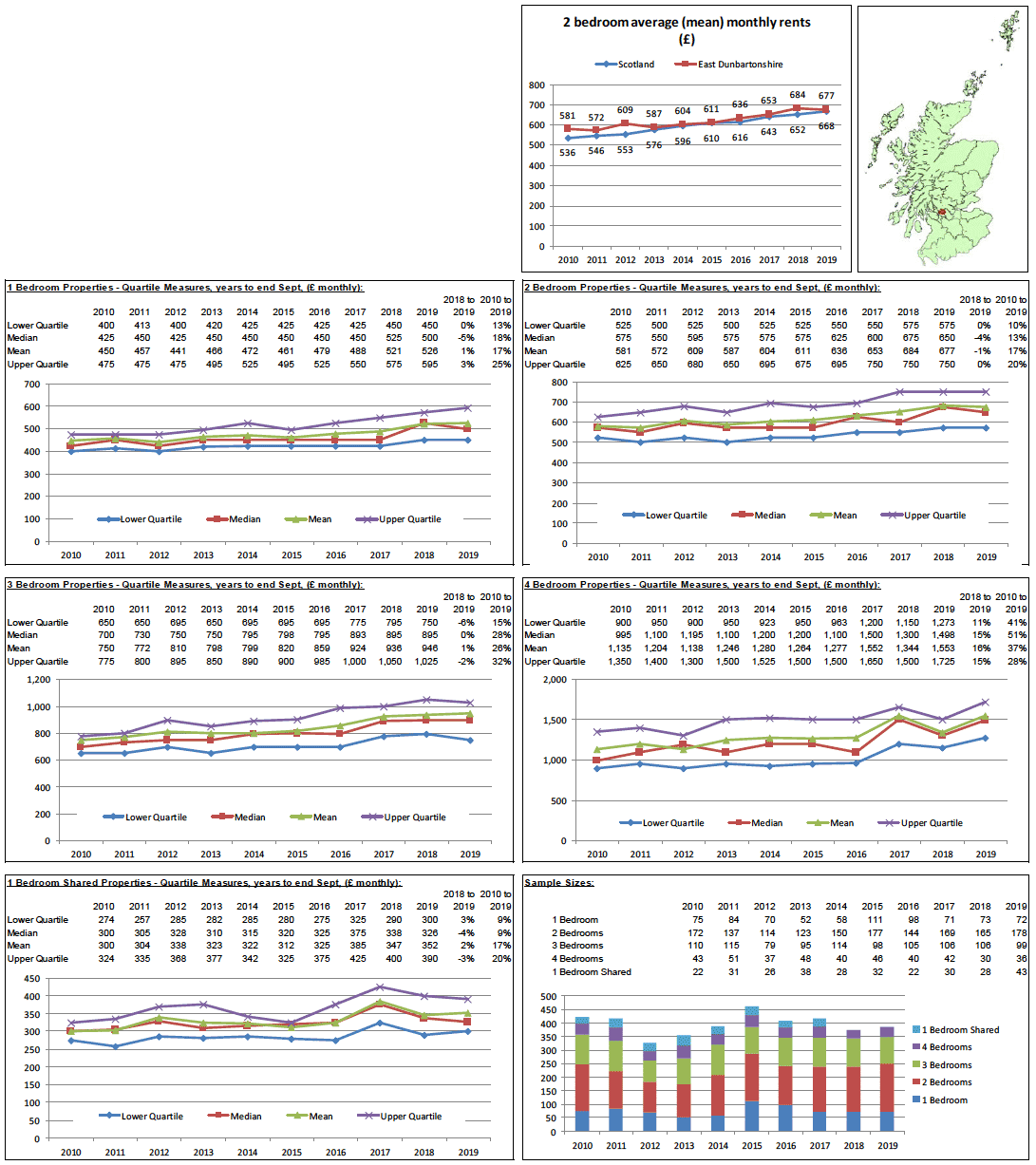
Broad Rental Market Area Profile - Fife
Average (mean) rents in Fife have increased for 1 bedroom (2.2%), 2 bedroom (3.4%), 3 bedroom (8.3%) and 4 bedroom (11.6%) properties, but decreased in 1 bedroom shared properties (-5.7%), which compares to CPI inflation of 1.7% across this time period between 2018 and 2019. Between 2010 and 2019 average rents have increased across all property sizes, ranging from an increase of 11.4% for 1 bedroom properties to an increase of 41.2% for 4 bedroom properties. This compares to CPI inflation of 20.8% across this time period.
For 4 bedroom properties, over the last two years increases in the top end (upper quartile) of rents has widened the gap in rents between the top and bottom ends of the market.
Average 2 bedroom rents have been lower than the Scotland average in each year since 2010, and the gap has grown slightly over the years but reduced slightly between 2018 and 2019, with the average rent in 2019 being £567 per month, compared to the Scotland average of £668.
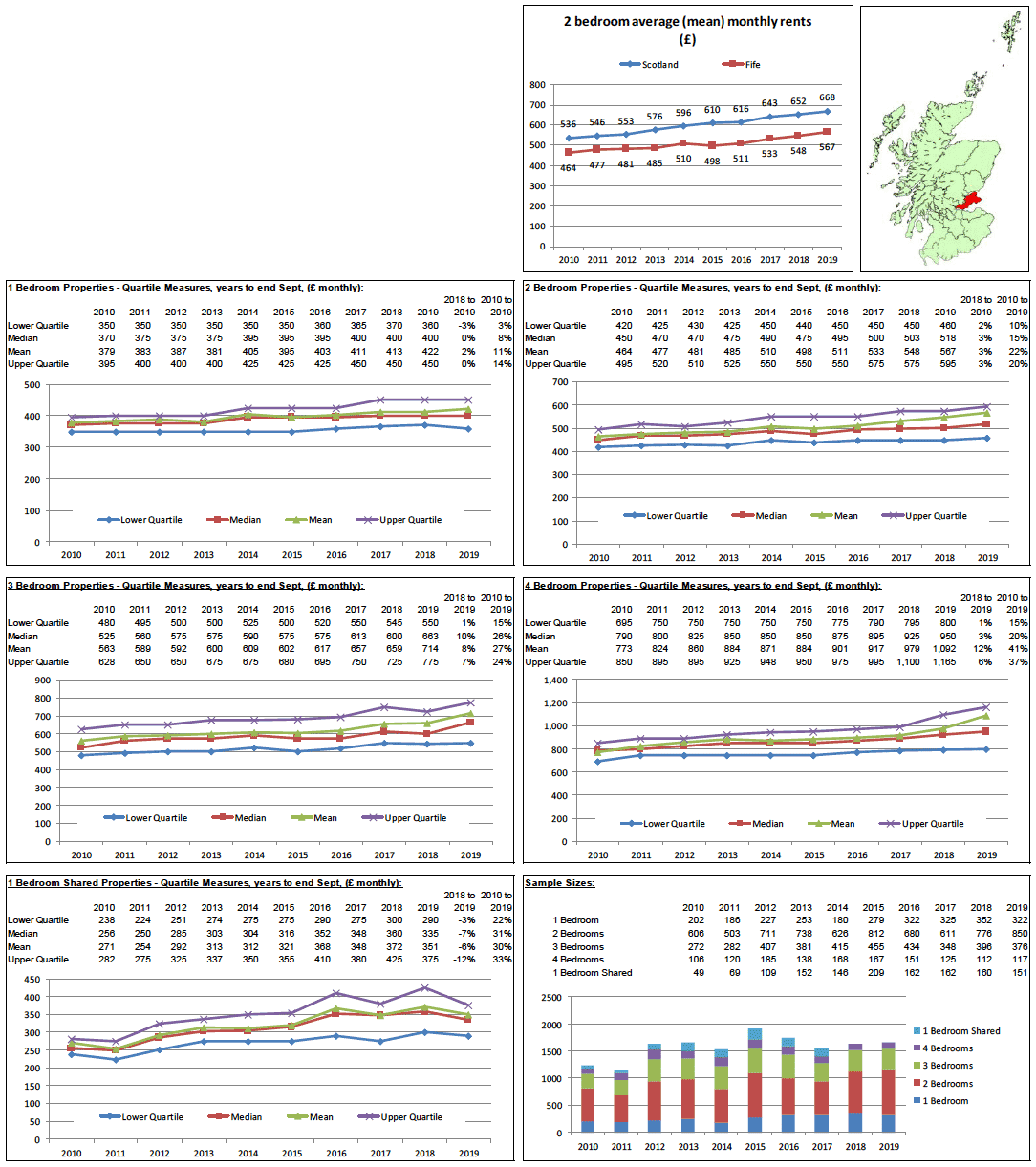
Broad Rental Market Area Profile - Forth Valley
Between 2018 and 2019, average (mean) rents in Forth Valley have increased for 1 bedroom (2.4%), 2 bedroom (1.2%), 3 bedroom (2.3%) and 4 bedroom (5.1%) properties, but decreased in 1 bedroom shared properties (-7.0%), which compares to CPI inflation of 1.7% across this time period. Average rents between 2010 and 2019 have increased for all property sizes. Increases range from 13.3% for 1 bedroom properties to 40.8% for 4 bedroom properties, which compares to CPI inflation of 20.8% across this time period.
Across 1, 2, 3 and 4 bedroom properties, since 2010 there have generally been greater increases in the top end rents (upper quartile) than the bottom end (lower quartile), resulting in the gap between top and bottom ends of the market widening slightly.
Average 2 bedroom rents have been lower than the Scotland average in each year since 2010, with the average rent in 2019 being £596 per month, compared to the Scotland average of £668. The gap grew between 2011 and 2015, then narrowed between 2016 and 2018. In 2019 the gap increased slightly.
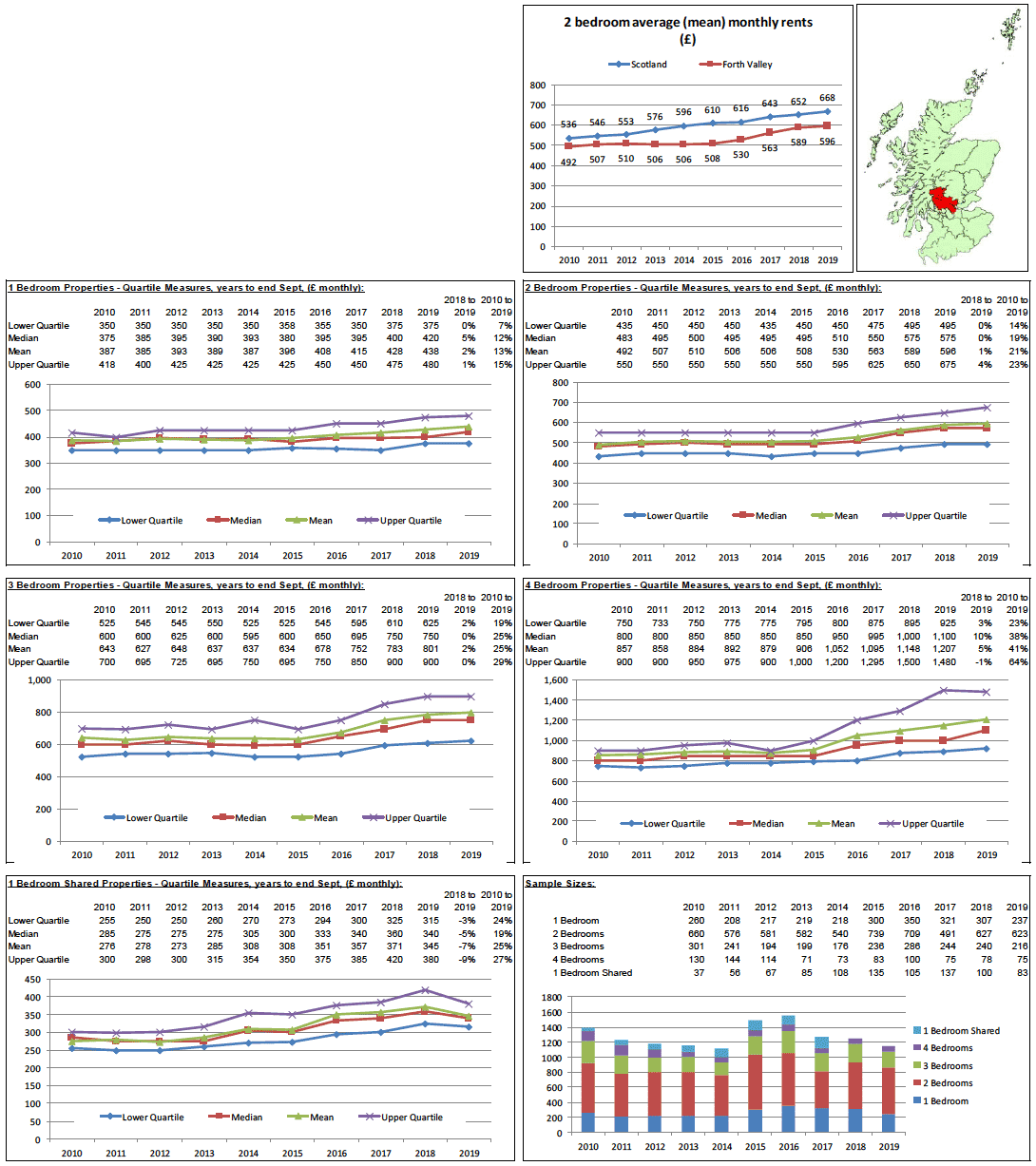
Broad Rental Market Area Profile - Greater Glasgow
Average (mean) rents in the Greater Glasgow area between 2010 and 2019 have showed increases in all bedroom sizes ranging from 2.2% for 1 bedroom properties to 5.8% for 4 bedroom properties, which compares to CPI inflation of 1.7% across this time period. Average rents have increased for all properties between 2010 and 2019, with increases ranging from 28.8% for 1 bedroom shared properties to 51.5% for 4 bedroom properties, which compares to CPI inflation of 20.8% across this time period.
For most property sizes there have generally been greater increases in the top end (upper quartile) of rents between 2010 and 2019, which has widened the gap in rents compared to the bottom end of the market (lower quartile).
Average 2 bedroom rents have been higher than the Scotland average in each year since 2010, and the difference has grown between 2014 and 2019 with the average rent in 2019 being £780 per month, compared to the Scotland average of £668.
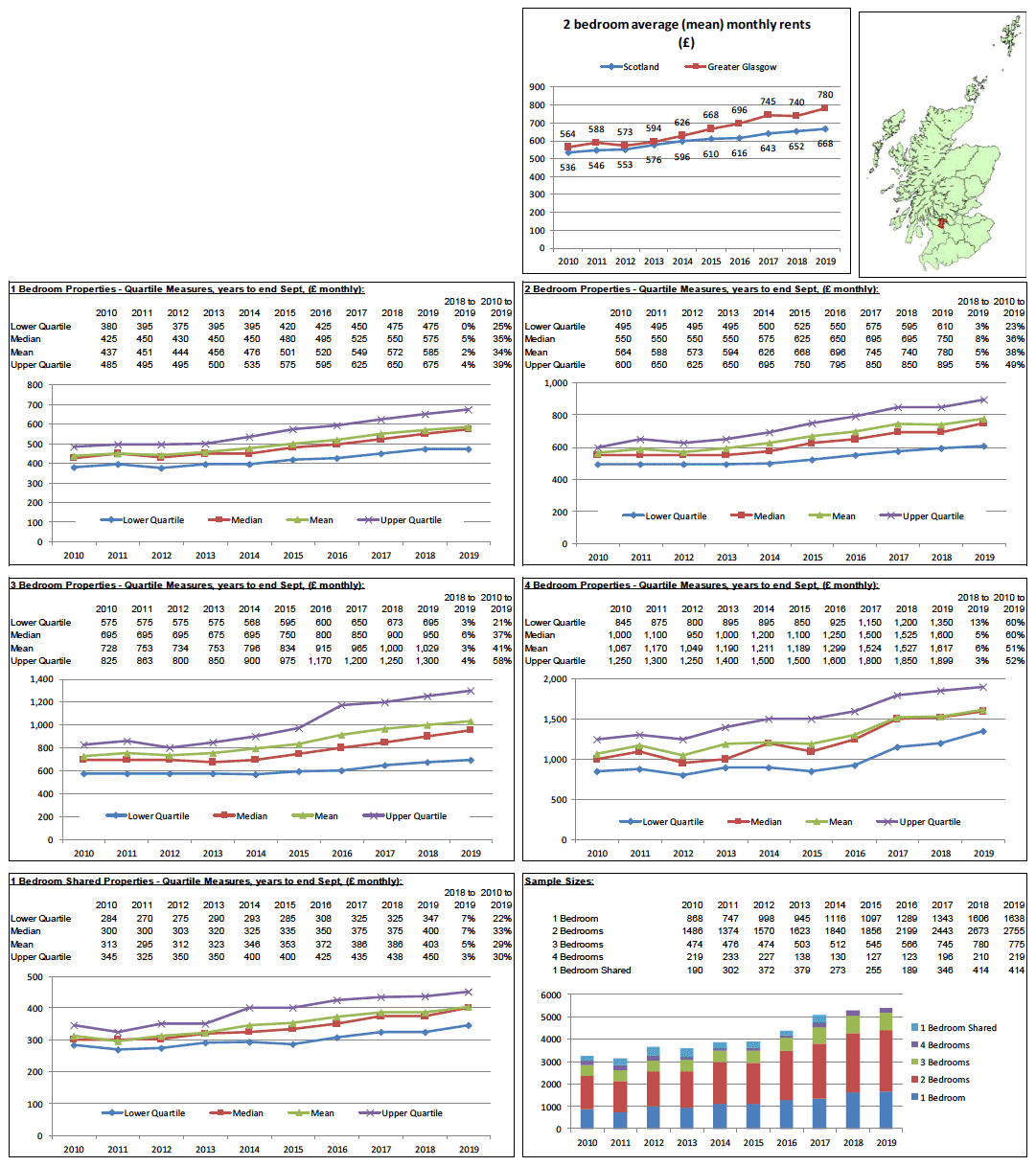
Broad Rental Market Area Profile - Highland and Islands
Average (mean) rents in the Highlands and Islands have increased for all property sizes between 2018 and 2019, apart from 1 bedroom shared properties which have remained the same. Increases have ranged from 1.5% for 1 bedroom properties, to 3.7% for 4 bedroom properties, which compares to CPI inflation of 1.7% across this time period. Average rents have increased for all property sizes between 2010 and 2019, ranging from an increase of 15.1% for 1 bedroom properties to an increase of 29.1% for 1 bedroom shared properties. This compares to CPI inflation of 20.8% across this time period.
For all property sizes there have generally been slightly greater increases at the top end (upper quartile) than the bottom end (lower quartile) of the market between 2010 and 2019, which has resulted in a widening gap between top and bottom ends of the market.
Average 2 bedroom rents have been lower than the Scotland average in each year since 2010, with the average rent in 2018 being £601 per month, compared to the Scotland average of £668.
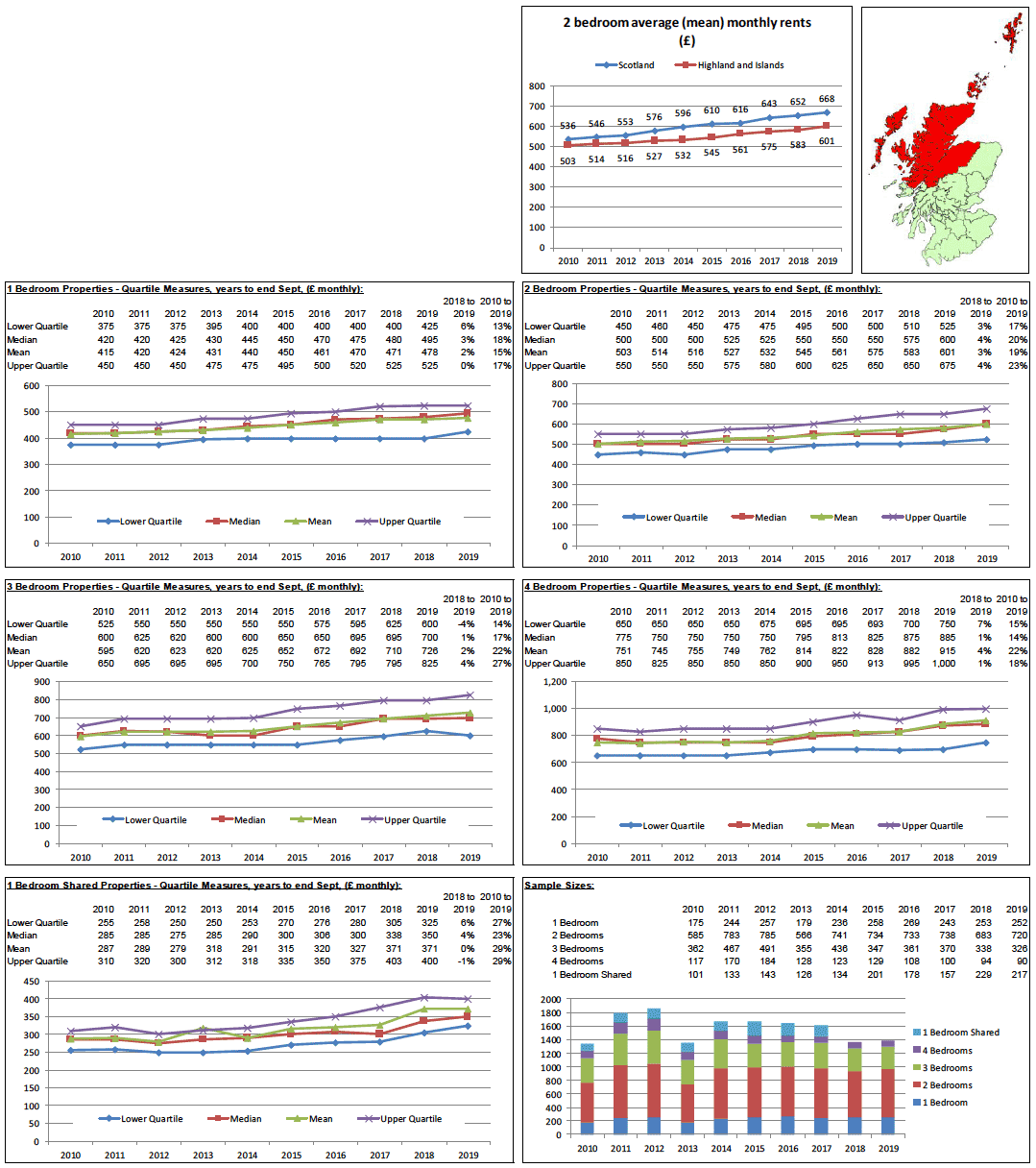
Broad Rental Market Area Profile - Lothian
Average (mean) rents in the Lothian area have increased between 2018 and 2019 for 1 bedroom (3.4%), 2 bedroom (2.8%), 4 bedroom (0.6%) and 1 bedroom shared (8.2%) properties, but decreased in 3 bedroom properties (-1.2%), which compares to CPI inflation of 1.7% across this time period between 2018 and 2019. Average rents have increased for all property sizes between 2010 and 2019. Increases over this time period ranged from 43.9% for 1 bedroom shared properties to 47.6% for 4 bedroom properties, which compares to CPI inflation of 20.8%.
For all property sizes except 1 bedroom properties, since 2010 increases in the top end (upper quartile) of rents have generally been greater than increases in the bottom end (lower quartile), which has widened the gap in rents.
Average 2 bedroom rents have been higher than the Scotland average in each year since 2010, and this difference has grown since 2013, with the average rent in 2019 being £972 per month, compared to the Scotland average of £668.
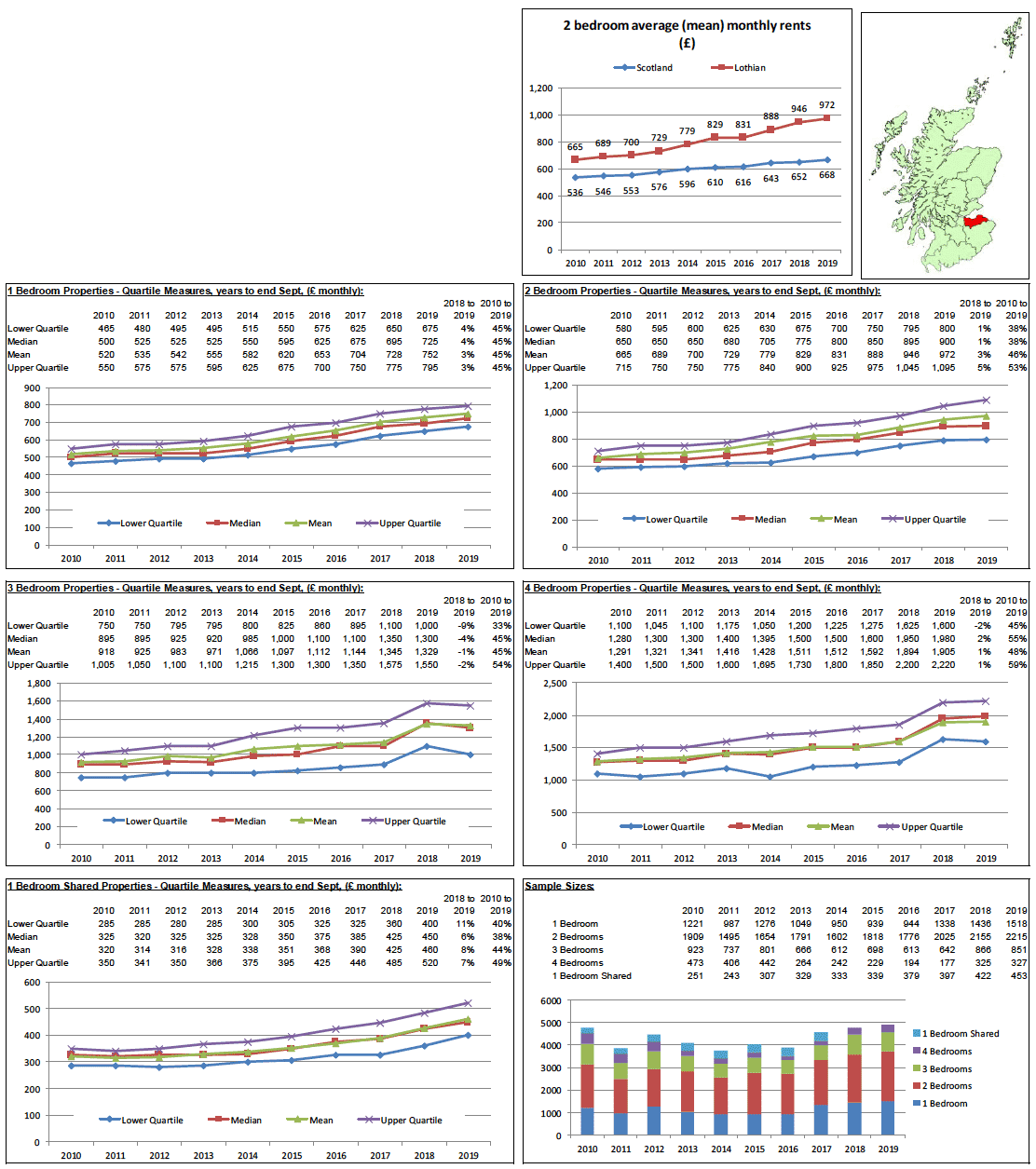
Broad Rental Market Area Profile - North Lanarkshire
Between 2018 and 2019, average (mean) rents in North Lanarkshire have increased slightly for 2 bedroom (0.2%) properties but have fallen for 1 bedroom properties (-0.7%), 3 bedroom (-4.0%) properties, 4 bedroom properties (-3.9%) and 1 bedroom shared (-8.3%) properties, which compares to CPI inflation of 1.7% across this time period. Average rents have increased for all property sizes between 2010 and 2019 with the largest increase of 14.7% being seen for 4 bedroom properties. This compares to CPI inflation of 20.8% across this time period.
For 4 bedroom properties, since 2010 increases in the top end (upper quartile) of rents have been greater than increases in the bottom end (lower quartile), which has widened the gap in rents, although this difference has narrowed slightly in the latest year.
Average 2 bedroom rents have been lower than the Scotland average in each year since 2010, and this gap has widened over the years, with the average rent in 2019 being £488 per month, compared to the Scotland average of £668.
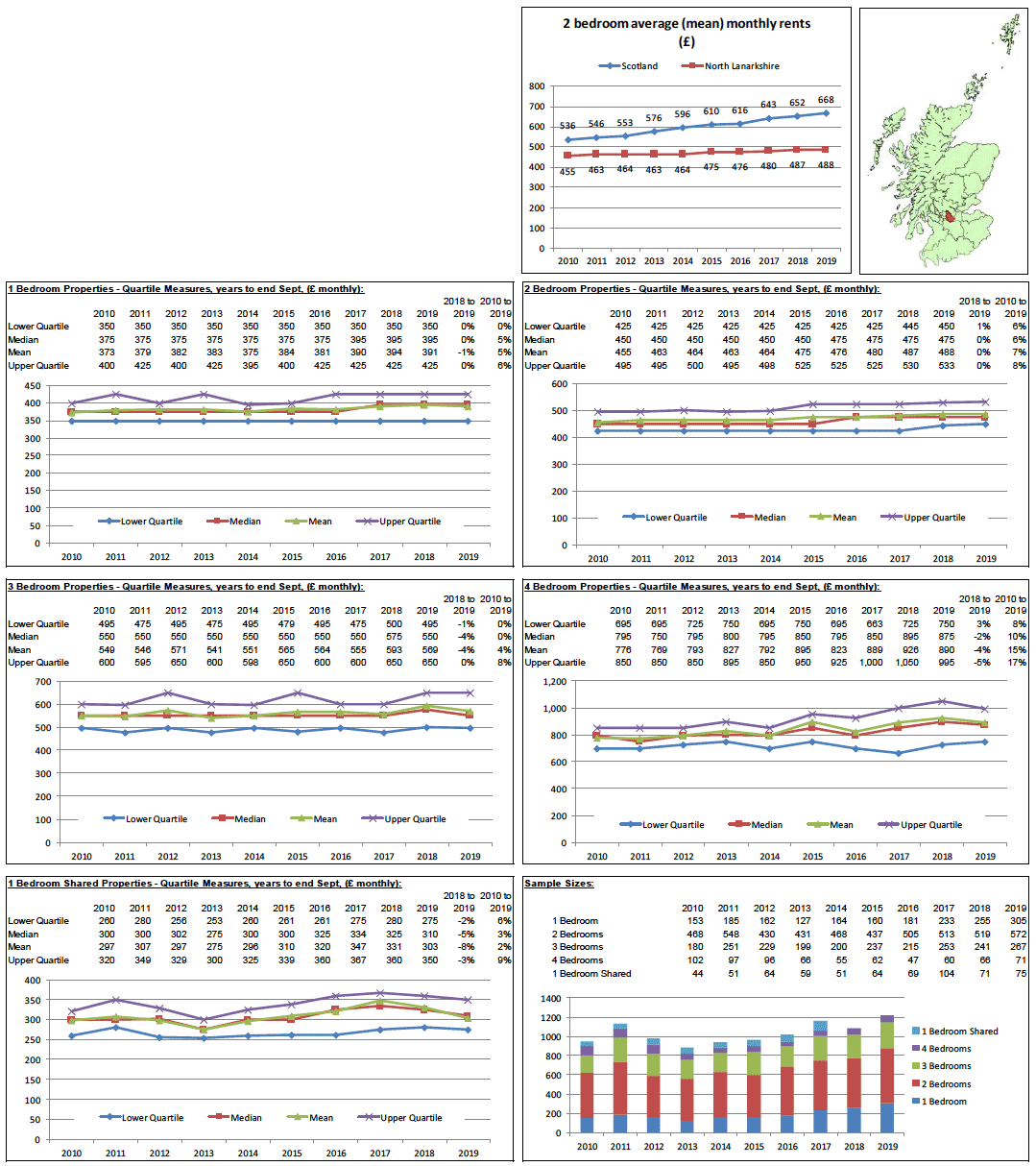
Broad Rental Market Area Profile - Perth and Kinross
Between 2018 and 2019, average (mean) rents in Perth and Kinross increased for all property sizes with increases seen for 1 bedroom properties (4.1%), 2 bedroom (2.4%), 3 bedroom (4.9%), 4 bedroom (6.4%) properties, and 1 bedroom shared properties (0.2%), which compares to CPI inflation of 1.7% across this time period.. Between 2010 and 2019 there have been increases in the average rent for all property sizes, ranging from 11.3% for 2 bedroom properties and 23.2% for 4 bedroom properties. This compares to CPI inflation of 20.8% across this time period.
For 3 bedroom, 4 bedroom and 1 bedroom shared properties, between 2018 and 2019 there has been a greater increase in the top end (upper quartile) rents compared to the bottom end (lower quartile), which has caused an increase in the gap between the top and the bottom of the market.
Average 2 bedroom rents have been lower than the Scotland average in each year since 2010, and the gap has widened over the years, with the average rent in 2019 being £564 per month, compared to the Scotland average of £668.
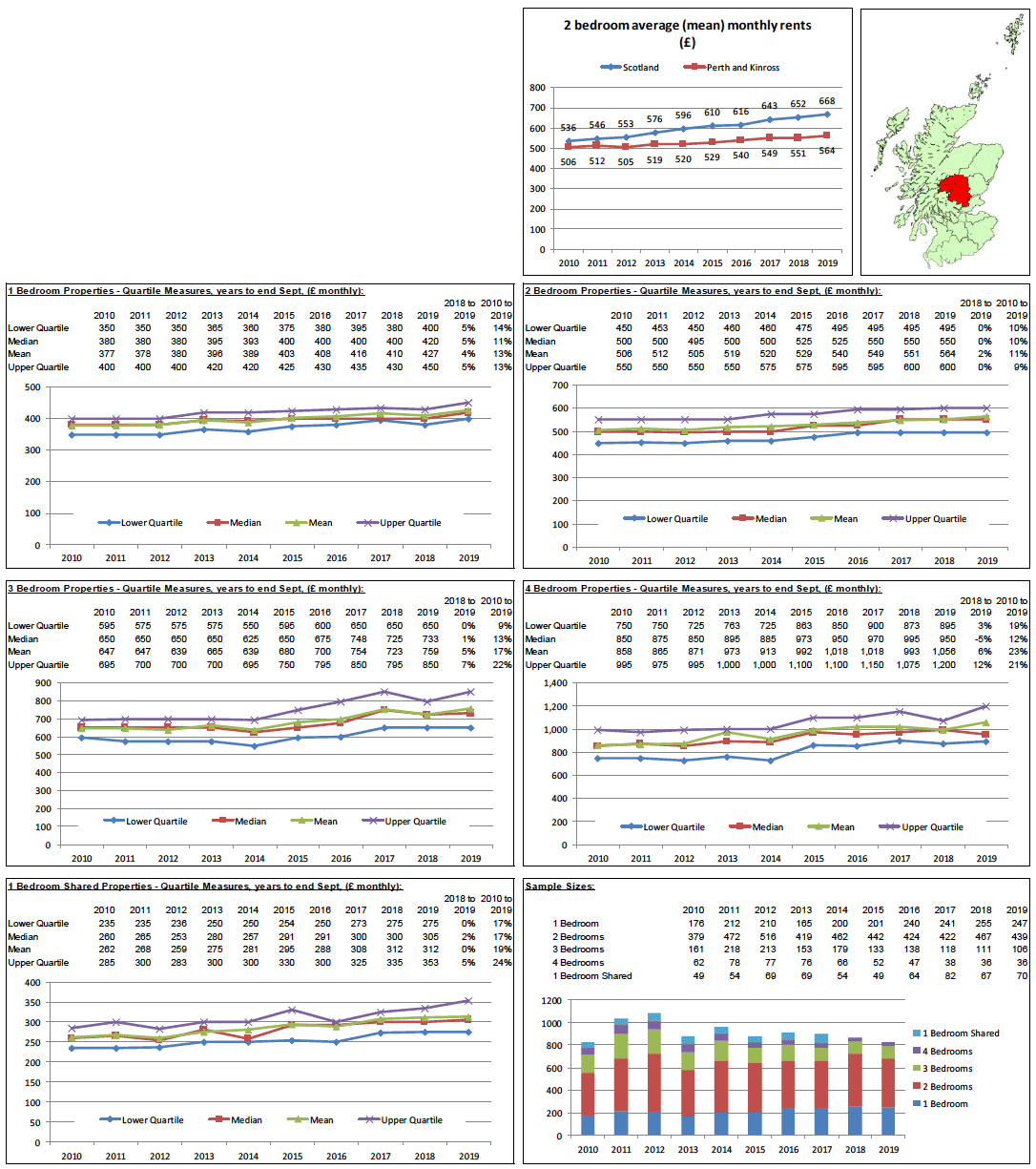
Broad Rental Market Area Profile - Renfrewshire / Inverclyde
Between 2018 and 2019, average (mean) rents have increased for 1 bedroom properties (1.9%), 2 bedroom properties (1.0%), 3 bedroom properties (1.5%), 4 bedroom properties (14.1%) and 1 bedroom shared (7.4%), which compares to CPI inflation of 1.7% across this time period. Between 2010 and 2019 average rents increased for all property sizes. Increases have ranged from 4.6% for 1 bedroom properties to 45.2% for 4 bedroom properties, which compares to CPI inflation of 20.8% across this time period.
For 4 bedroom properties sizes, there has been an increase in both the top end (upper quartile) rents and the bottom end (lower quartile) in the latest year.
Average 2 bedroom rents have been lower than the Scotland average in each year since 2010, and the gap has widened over the years, with the average rent in 2019 being £513 per month, compared to the Scotland average of £668.
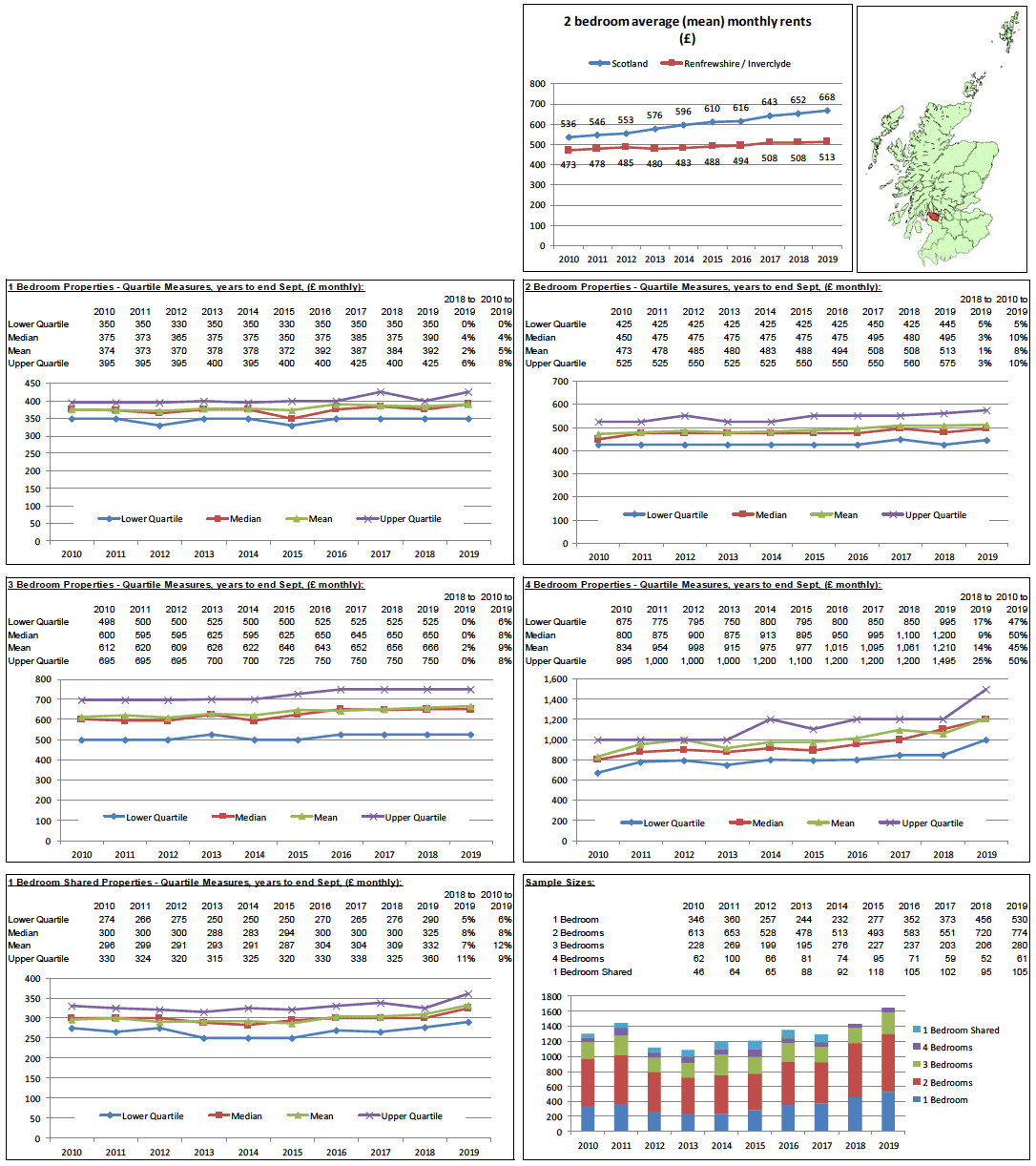
Broad Rental Market Area Profile - Scottish Borders
Between 2018 and 2019, average (mean) rent in the Scottish Borders increased for 1 bedroom (0.7%) properties, 2 bedroom (2.6%) properties, 3 bedroom (4.1%) and 4 bedroom (5.3%) but have fallen for 1 bedroom shared (-14.9%) properties , which compares to CPI inflation of 1.7% across this time period. The fall in rents for 1 bedroom shared properties in the latest year follows a 14.4% increase between 2017 and 2018. Average rents have also increased for all property sizes between 2010 and 2019, with increases ranging from 7.0% to 43.8% for 1 bedroom and 4 bedroom shared properties, respectively. This compares to CPI inflation of 20.8% across this time period.
In the latest year, the gap between the top end rents (upper quartile) and the bottom end (lower quartile) has increased for 2 bedroom and 4 bedroom properties.
Average 2 bedroom rents have been lower than the Scotland average in each year since 2010, and the gap has widened over the years, with the average rent in 2019 being £490 per month, compared to the Scotland average of £668.
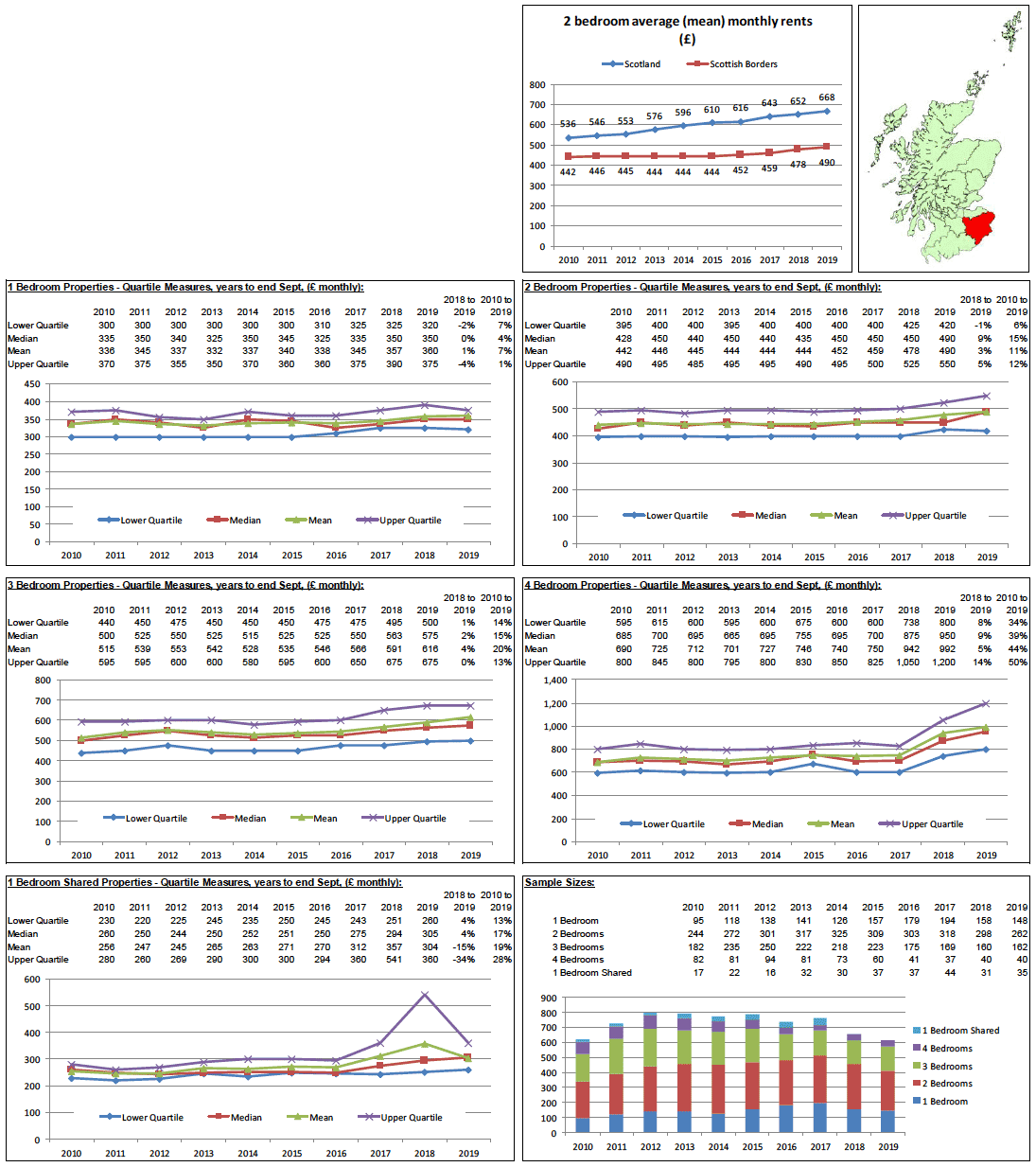
Broad Rental Market Area Profile - South Lanarkshire
Average (mean) rent in South Lanarkshire have increased between 2018 and 2019 for 1 bedroom (2.3%), 2 bedroom (1.4%), 3 bedroom (1.3%), and 4 bedroom properties (2.6%), but have fallen for 1 bedroom shared properties (-0.9%), which compares to CPI inflation of 1.7% across this time period. Average rents have increased between 2010 and 2019 for all property sizes, ranging from 6.2% for 1 bedroom shared properties to 26.3% for 4 bedroom properties. This compares to CPI inflation of 20.8% across this time period.
For all property sizes, since 2010 increases in the top end (upper quartile) of rents have generally been slightly greater than increases in the bottom end (lower quartile), which has widened the gap in rents slightly.
Average 2 bedroom rents have been lower than the Scotland average in each year since 2010, the gap has widened over the years, with the average rent in 2018 being £533 per month, compared to the Scotland average of £668.
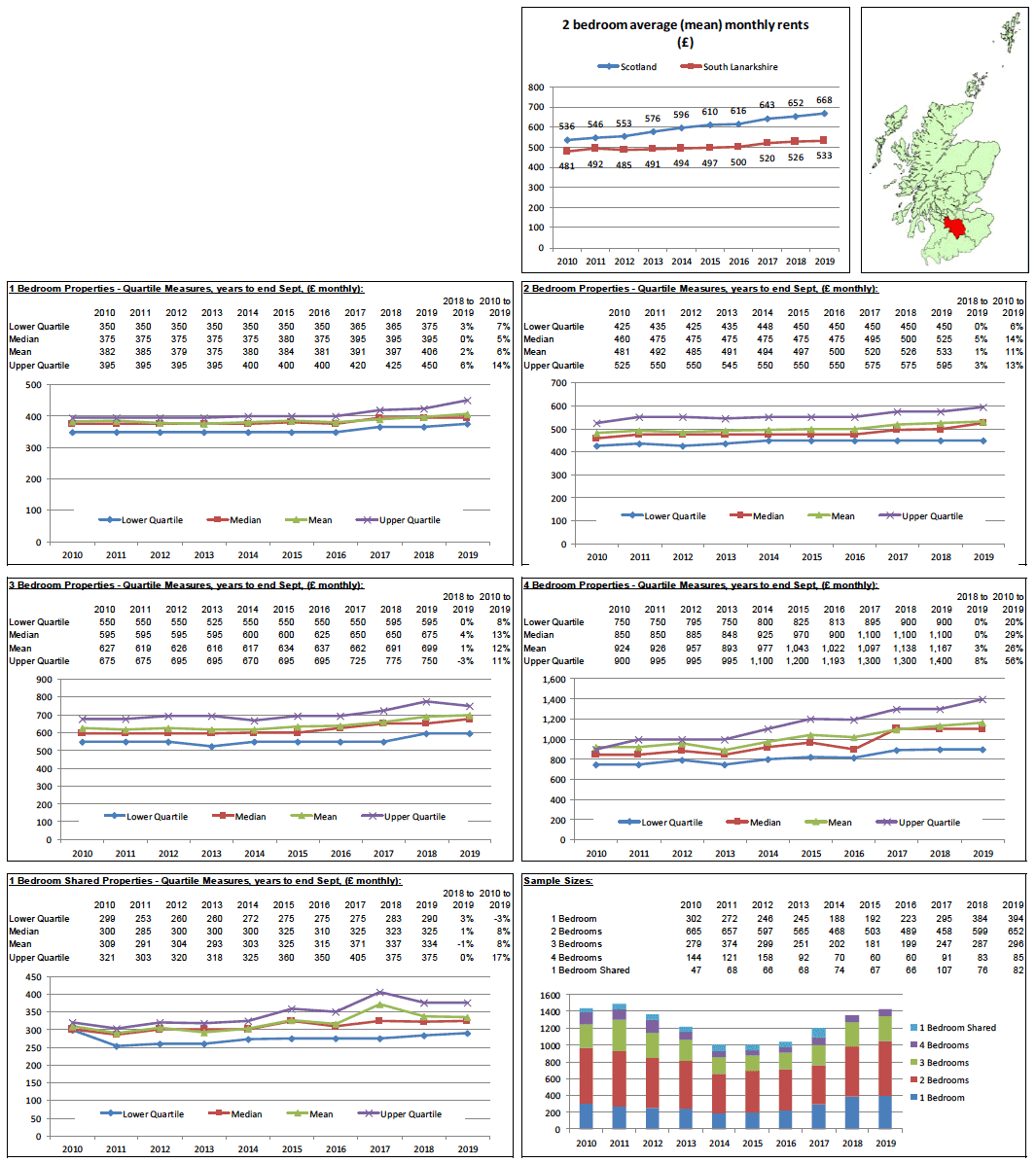
Broad Rental Market Area Profile - West Dunbartonshire
Average (mean) rents between 2018 and 2019 have increased for 2 bedroom (1.1%), 3 bedroom (0.7%), 4 bedroom (16.2%), and 1 bedroom shared properties (6.7%), but have fallen for 1 bedroom properties (-0.4%) which compares to CPI inflation of 1.7% across this time period. Average rents have increased for all property sizes between 2010 and 2019. Increases ranged from 1.6% for 1 bedroom properties and 54.2% for 4 bedroom properties. This compares to CPI inflation of 20.8% across this time period. When interpeting these figures, it is important to note the very small sample size for 4 bedroom properties in 2018 and 2019 (7 and 6, respectively).
For 4 bedroom properties, since 2017 increases in the top end (upper quartile) greater than for those in the bottom end (lower quartile) have widened the gap between the top and bottom of the market.
Average 2 bedroom rents have been lower than the Scotland average in each year since 2010, and the gap has widened over the years, with the average rent in 2019 being £509 per month, compared to the Scotland average of £668.
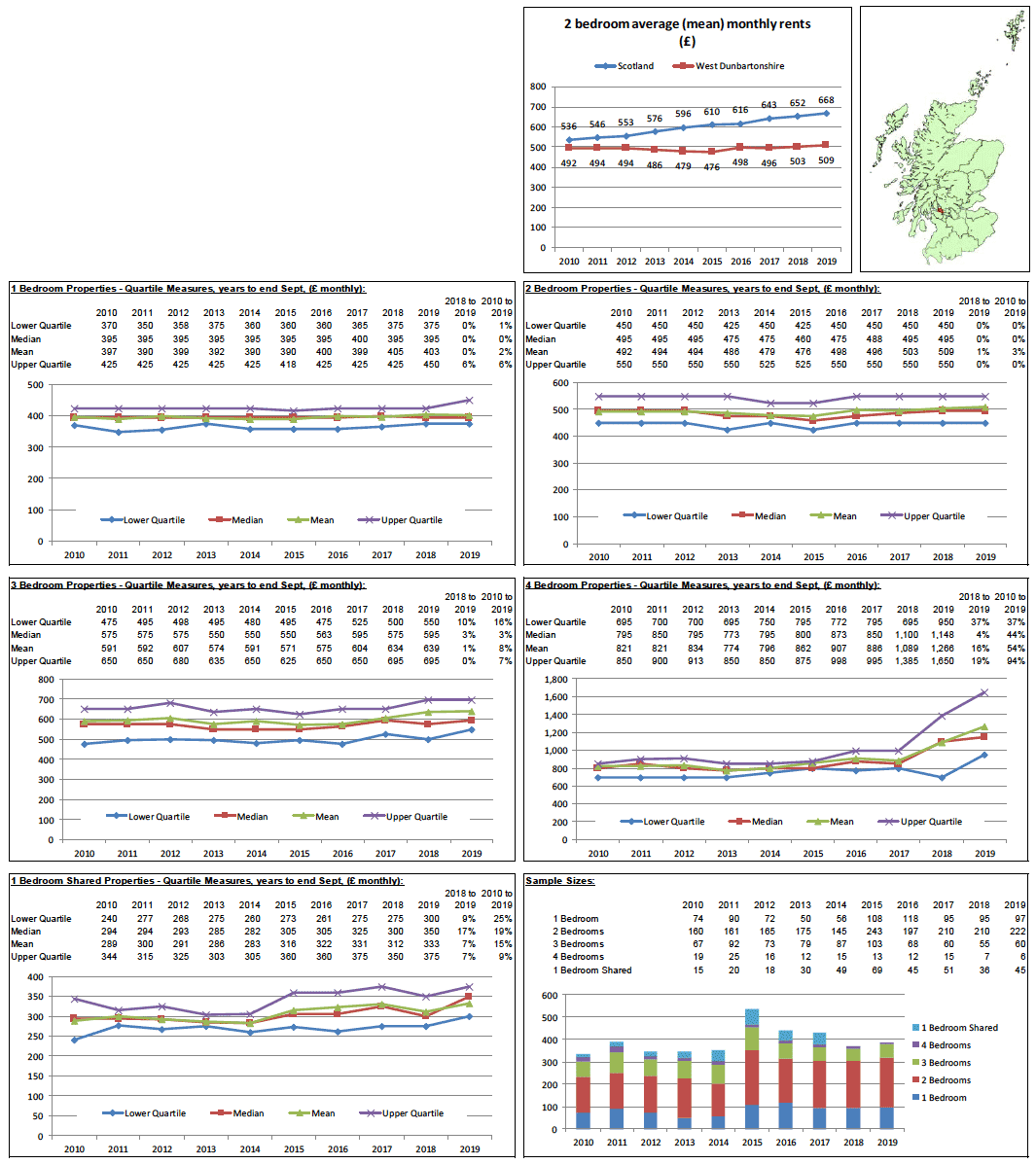
Broad Rental Market Area Profile - West Lothian
Average (mean) rents in West Lothian between 2018 and 2019 have increased for 1 bedroom properties (2.8%), 2 bedroom properties (3.4%), 3 bedroom properties (4.6%) and 4 bedroom properties (4.8%), but have decreased for 1 bedroom shared properties (-3.2%) which compares to CPI inflation of 1.7% across this time period. Average rents have also increased for all property sizes between 2010 and 2019. Increases range from 17.6% (1 bedroom properties) to 26.5% (4 bedroom properties), which compares to CPI inflation of 20.8% across this time period.
For 3 and 4 bedroom properties, increases at the top end of the market (upper quartile) between 2010 and 2019 have generally been higher than increases in the bottom end (lower quartile) increasing the gap in rents between the top and bottom of the market slightly.
Average 2 bedroom rents have been lower than the Scotland average in each year since 2010, with the average rent in 2018 being £630 per month, compared to the Scotland average of £668.
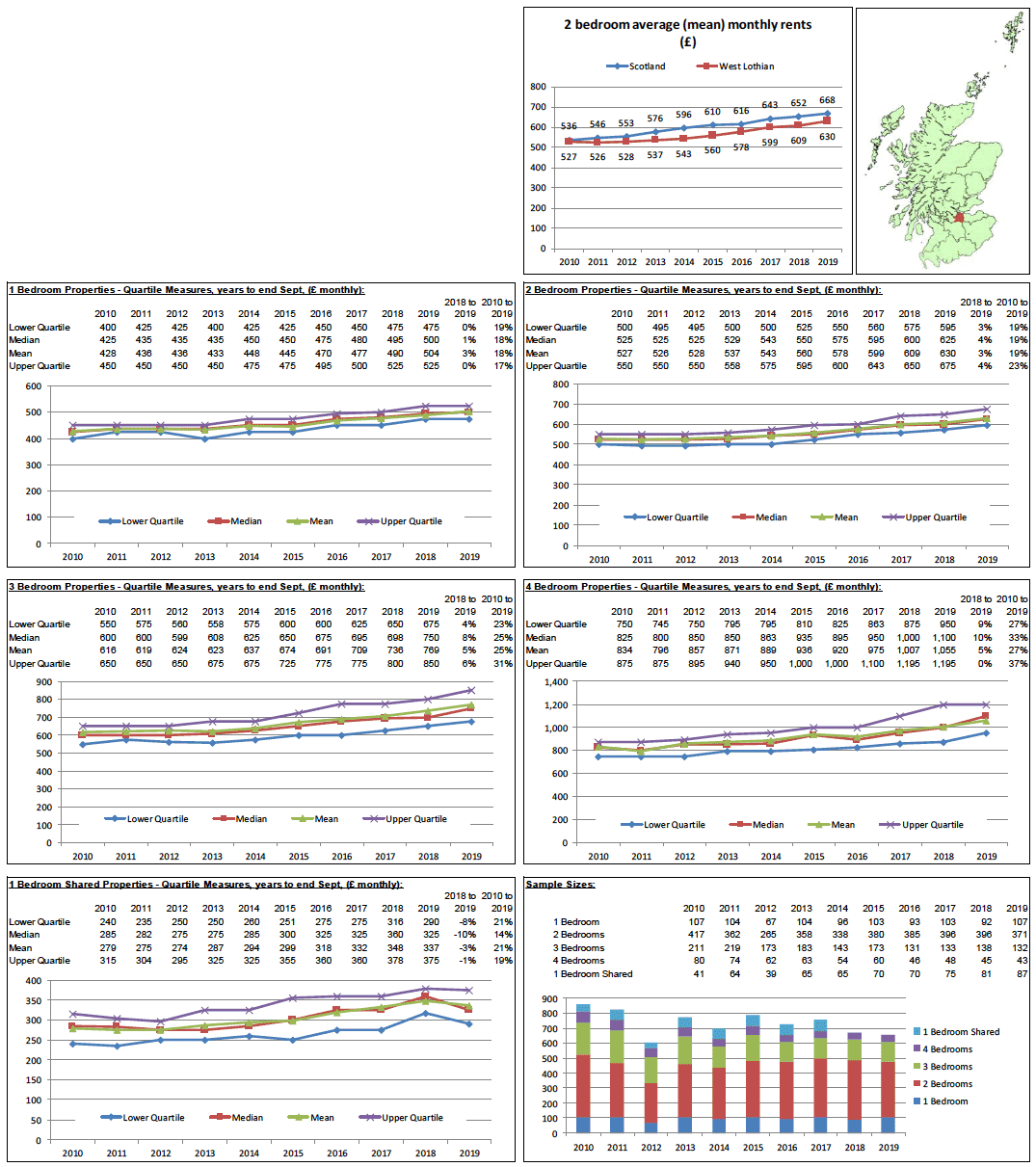
Contact
Email: felix.palin@gov.scot
There is a problem
Thanks for your feedback